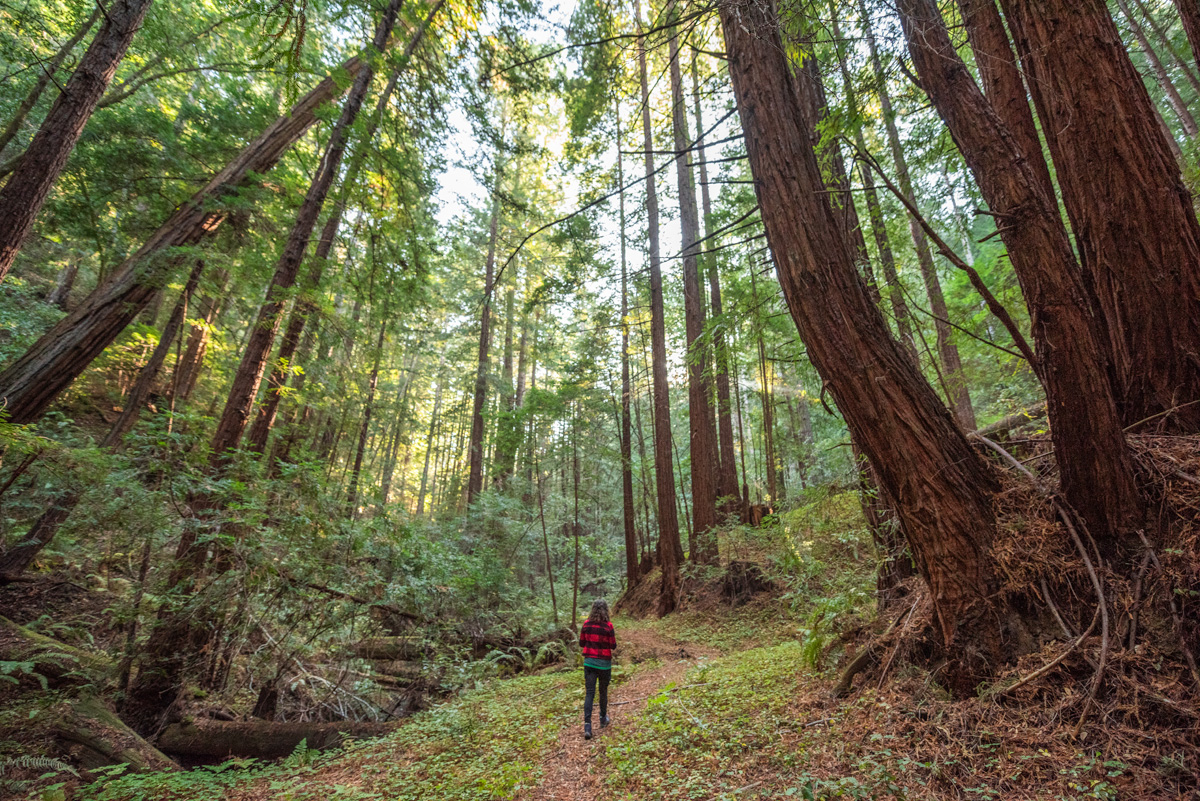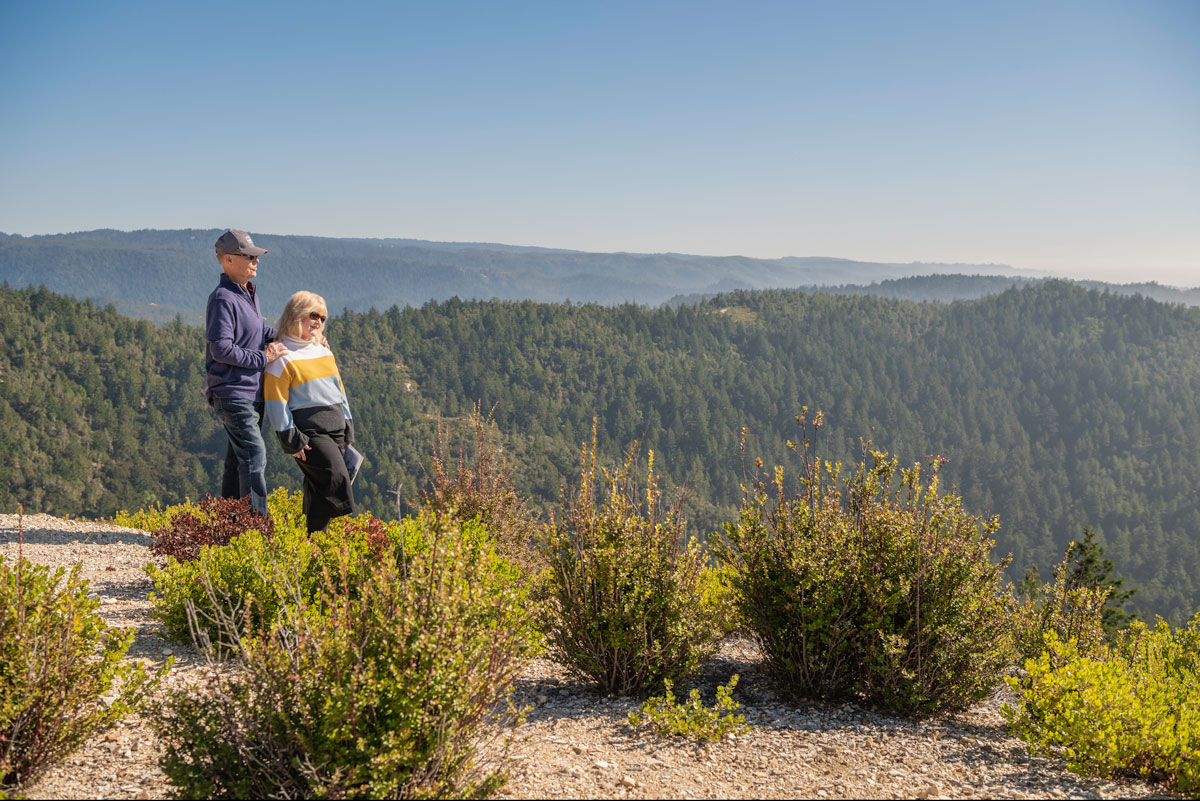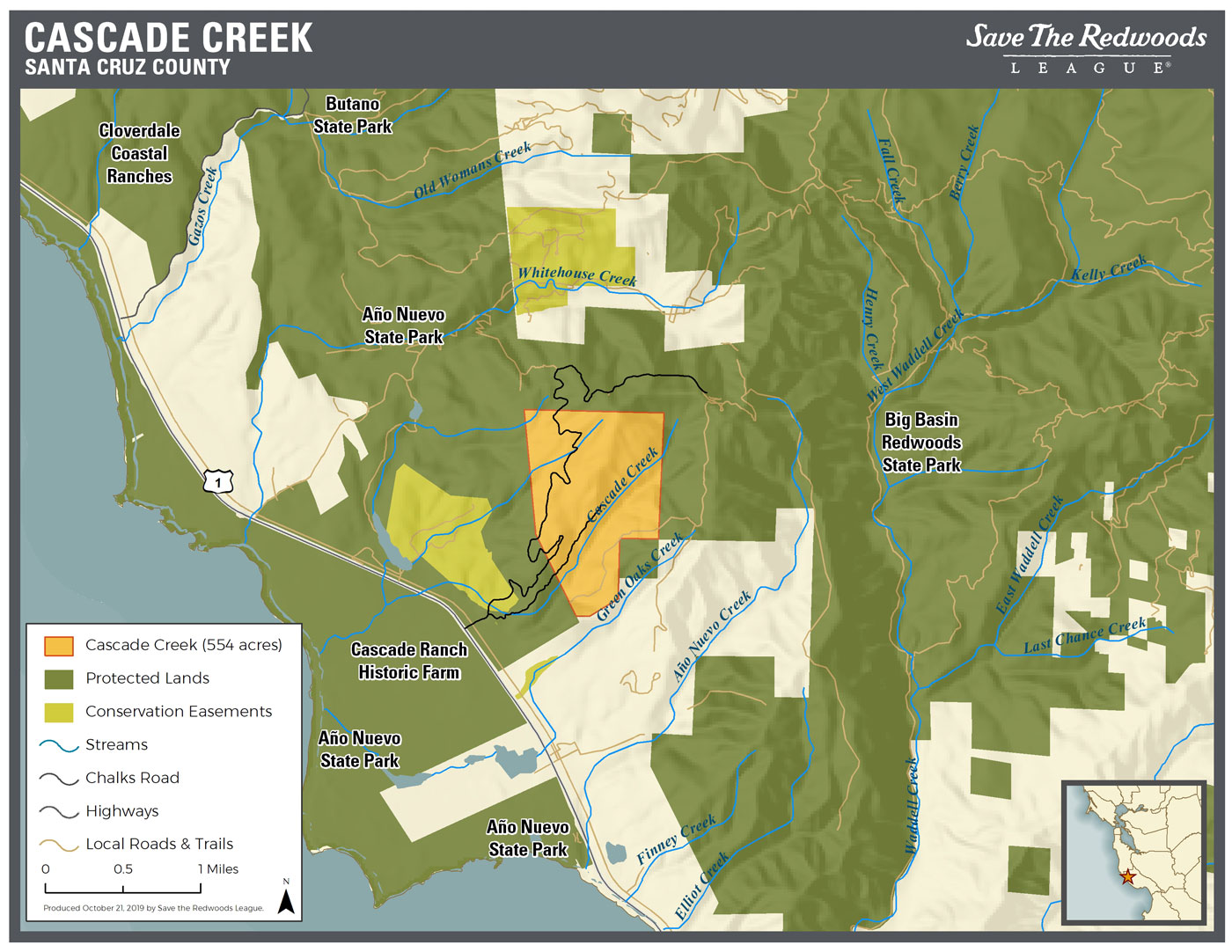Tucked between Big Basin Redwoods and Año Nuevo State Parks, on the ancestral territory of the Quiroste Tribe, Cascade Creek evokes a lost era, when primeval forest dominated the San Francisco Bay Area. Ancient coast redwoods tower over the property’s namesake, Cascade Creek, and redwoods young and old live on the upper slopes.
In December 2020, Save the Redwoods League, in partnership with Peninsula Open Space Trust (POST), purchased this property for $9 million, concluding seven years of negotiation. The acquisition creates continuous protected redwood habitat from the Santa Cruz Mountains to the Pacific Ocean and safeguards the long-term health of this keystone forest. An additional $600,000 was secured to steward the property during the League’s ownership.
While the entire Cascade Creek property experienced wildfire during the CZU Lightning Complex in August 2020, most of the coast redwoods appear to have survived, and the forest is already showing signs of recovery. Having raised all the funds needed for acquisition and stewardship in May 2020, the League moved forward with the purchase because of the property’s high ecological value. By connecting Big Basin Redwoods with the coastal prairies, wetland marshes, dune fields, and ocean bluffs of Año Nuevo, the property provides contiguous habitat for myriad native wildlife species that traverse this landscape, including mountain lions, black-tailed deer, bobcats, coyotes, gray foxes, and ringtails, as well as raptors and songbirds. Protection of this 564-acre property is thus crucial—not just for the rich natural assets of the property, but also for the biodiversity and long-term ecological health of lands from the Santa Cruz Mountains to the Pacific Ocean.

While the property’s forests and wildlife thrived under the rigorous, decades-long stewardship of the previous owner, the Holmes family, there was no certainty that future owners would have the same ethic—particularly with several spots on the property suitable for development of private home sites with ocean views.
In addition to protecting this forest from future development, the League also recognizes the need to secure fire-resilient lands in the face of climate change. Home to substantial old-growth and mature second-growth redwoods, Cascade Creek will provide stable carbon storage in a fire-impacted landscape once it has recovered. While the fire impacts in the forest may be apparent for a few years, ferns, sorrel, and other understory plants are already sprouting back, and the redwood trees are sprouting stems up and down their trunks and along their branches. This quick regeneration forms a stable foundation on which the broader forest habitat recovery will build.
The League plans to steward the property while studying the post-fire forest and ultimately developing a public access plan before transferring the land to a permanent steward. Our initial post-fire rehabilitation at Cascade Creek focused on protecting Chalks Road and the creekside trail from erosion and hazards. In the longer term, the League’s Director of Restoration Richard Campbell says that we will take the least-intensive approach, focusing on natural recovery wherever possible. This means managing invasive species, monitoring natural regeneration of the forest, and planting on an enrichment basis where natural regeneration is not adequate.
Cascade Creek is one of the flagship projects of the first comprehensive campaign for the redwoods, Forever Forest, a six-year venture launched by Save the Redwoods League to garner support for the organization’s ambitious vision for the next century of redwoods conservation. The League’s goal is to raise $120 million by 2022 to fund the first six years of this centennial vision, which includes protecting entire landscapes through large-scale, strategic land acquisitions; restoring young redwood forests to become the old-growth forests of the future; and connecting all people with the beauty and power of the redwoods through transformational park experiences.
Lead gifts to support the protection and restoration of Cascade Creek came from League Councilor Ralph Eschenbach together with his wife Dr. Carol Joy Provan, the Gordon and Betty Moore Foundation, project partner Peninsula Open Space Trust (POST), and the California State Coastal Conservancy. The Holmes family also agreed to reduce the purchase price, which amounted to nearly a $1 million discount on the sale of the property.

Catherine Elliott, the League’s Senior Manager of Land Protection, noted that this project would not have been possible without the generosity of the Holmes family. “The price we’re paying for the property is well below market value, even after the fire, ” Elliott added. “The family’s foremost priority throughout our discussions was permanent protection for their beloved forest, not profit.”
The Holmes family has a long association with the redwood forest. Larry Holmes, the family’s representative in the Cascade Creek negotiations, said his father opened a sawmill in Arcata in 1949 to process redwood timber. In 1957, the family acquired a second mill near Santa Cruz to process second-growth timber and bought Cascade Creek in 1978.
While some logging was conducted on the property over the last 125 years, Cascade Creek has more than 100 acres of old growth and numerous stands of large second growth. League researchers studied four of the old trees and dated them between 420 and 528 years old. They also identified a 100-year-old second-growth tree that has grown remarkably fast—it is now larger than and nearly as tall as the oldest tree studied.
“Most of the logging was of the ‘hunt-and-peck’ variety through the 1940s,” Elliott said, “and some selective harvesting was conducted in the mid-1980s. But we’re incredibly excited about the large number of old-growth trees that remain, and the quality of the older second-growth redwoods. Many are quite large, and we’re confident that with protection, they will acquire old-growth characteristics over time.”
Larry Holmes said, “It’s a piece of property that should be a part of the state parks. We’ve known that for many years. And then when you realize that 95 percent of the old-growth redwoods were cut at one time, it’s very important to us to save the redwood trees.”
Cascade Creek is also remarkable for other natural features. The namesake creek flows down through the forest and over the 50-foot Cascade Falls just south of the property on state park land. Marbled murrelets have been spotted in the area, and it’s likely the property’s ancient redwoods provide nesting habitat for these seabirds. The marbled murrelet is listed as threatened under the federal Endangered Species Act and endangered under California’s Endangered Species Act.
Along with protecting an extraordinary natural landscape, the Cascade Creek agreement will have the potential to offer more recreational opportunities for visitors to the Santa Cruz Mountains. In the future, visitors will likely be able to hike from Año Nuevo State Park (on the inland side of Highway 1) and up into the forest along Cascade Creek. Larry Holmes and Bronia Holmes, his wife, are pleased by that likelihood.
“The main reasons we want to save this property are for future generations, for my grandchildren, their children, and for the planet,” said Bronia. “It’s a good feeling knowing that it’s going to be forever preserved.”
